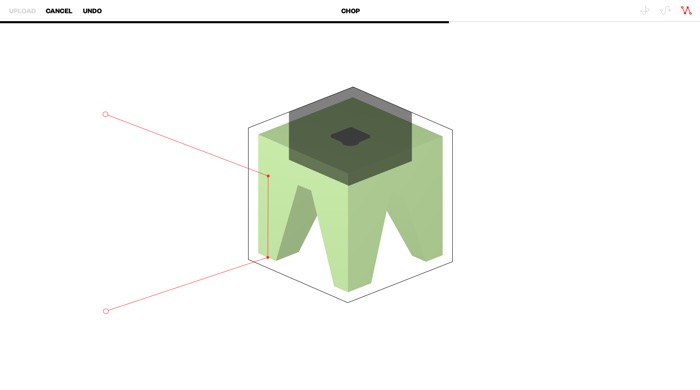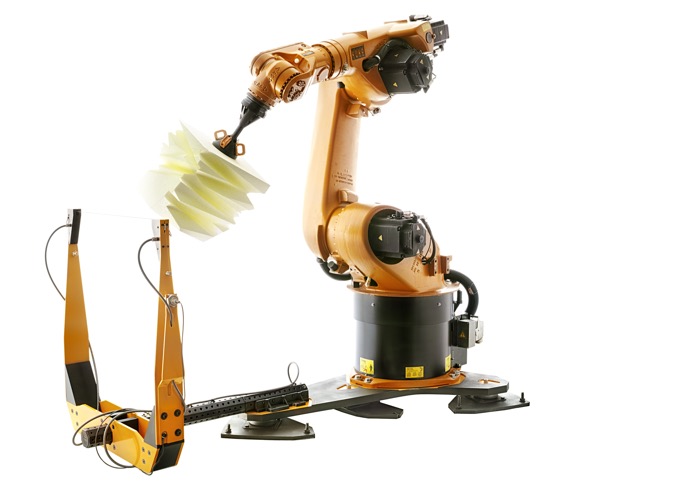Robochop: controlling factory robots via the Internet
Published 16 March 2015 by Nicolas Barrial
Robochop is an experiment presented through March 20 at the CeBit exhibition and conference in Hanover, which spotlights new industrial trends on the Internet. Using an online interface, individuals can remotely experience the fabrication of objects by factory robots.
Robochop, conceived by German designers Reed Kram and Clemens Weisshaar, utilizes four KUKA KR60 robot arms, known for their precision and speed. An interface accessible both online and at CeBit allows visitors to design the laser-cutting of 2,000 40-centimeter polystyrene cubes (which are durable, according to the designers). The results of the selected designs will be announced during the show.
Presentation of Robochop:
“You have run out of robot fuel”
We tried our hand at the interface. It’s pretty simple, even minimalistic. It would have been nice to have a grid to help guide the symmetry. Then there’s the challenge of actually being selected for laser-cutting at the show… without leaving home!
Click “CHOP” to cut the parts one by one. You can either proceed from point to point or draw lines. Always start from the outside of the cube and don’t cross the lines. A freehand tool is also available for the more audacious. But bear in mind that economic reality can catch up with you, as a “You have run out of robot fuel” message is displayed when you spend too long in the factory.
While the project makes 3D laser-cutting fun and educational for the public, the designers aim primarily to promote the process within the industry. CeBit is still a professional conference, and the Code_n exhibition, where Robochop is showing, explores new economic models based on digital tools.

From game to fabrication
This isn’t the first time that designers Clemens Weisshaar and Reed Kram, who work in the automobile industry (Audi, Volkswagen), art (MoMA) and fashion (Prada), have attempted to connect the general public to the factories. In 2010, they launched the interactive installation OUTRACE in London’s Trafalgar Square, which used Audi’s robot arms to draw luminous messages. “Robochop takes us to a new stage, where users can fabricate and possess real objects instead of simply playing with the medium,” say the designers.
Clemens Weisshaar believes that plugins linking the Web to industrial fabrication infrastructures are imminent. “It’s doable, it’s just a question of taking the initiative to do what we did here—write the code, test it, improve it. The big question is who will take this initiative.”
Just for fun, I asked them if they had already thought of a name to describe these new processes of accessing industrial tools. “Robfab” is one option, according to Clemens, who confirms that we can also speak of linear automation. The Robochop approach can apply to all machines, even if the robot is still “the sexiest horse in the industrial stable”.

Making machines smart
For Clemens—visibly inclined to promote Made in Germany—Germany and its industry are well placed to lead the field of Robfab. He believes that a change in paradigm must take place as soon as possible within the economic motor of the Mittelstand (Germany’s small and medium-sized enterprises). “It’s no longer a question of the reality of the industrial Internet. If Germans want to continue making the best machines in the world, they will have to make them smart.”
According to the designer, major industries are already experiencing the industrial Internet—just as consumers’ demand is increasing. “When you click ‘ORDER’, you’re triggering an incalculable number of processes for purchasing, logistics, fabrication.” Robochop simplifies things, while also allowing users to go beyond merely customizing a product to the tailored fabrication of a piece that was entirely conceived by the user. “The industry will reverberate with a disruptive force. Some will welcome it with interest, while others will find it terrifying,” Clemens predicts.
